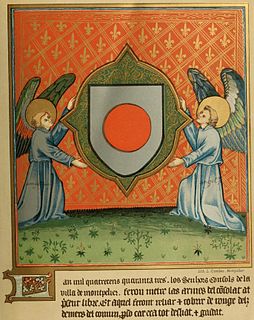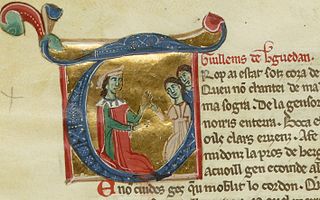
Alfonso II, called the Chaste or the Troubadour, was the King of Aragon and, as Alfons I, the Count of Barcelona from 1164 until his death. The eldest son of Count Ramon Berenguer IV of Barcelona and Queen Petronilla of Aragon, he was the first King of Aragon who was also Count of Barcelona. He was also Count of Provence, which he conquered from Douce II, from 1166 until 1173, when he ceded it to his brother, Ramon Berenguer III. His reign has been characterised by nationalistic and nostalgic Catalan historians as l'engrandiment occitànic or "the Pyrenean unity": a great scheme to unite various lands on both sides of the Pyrenees under the rule of the House of Barcelona.

Ramiro II, called the Monk, was the ruler of the Kingdom of Aragon from 1134 until withdrawing from public life in 1137. Although a monk, he was elected king by the Aragonese nobility upon the death of his childless brother, Alfonso the Battler. He then had a daughter, Petronilla, whom he had marry Count Ramon Berenguer IV of Barcelona, unifying Aragon and Barcelona into the Crown of Aragon.
Petronilla, whose name is also spelled Petronila or Petronella, was the queen of Aragon from the abdication of her father, Ramiro II, in 1137 until her own abdication in 1164. After her abdication she acted as regent during the minority of her son (1164–1173). She was the last ruling member of the Jiménez dynasty in Aragon, and by marriage brought the throne to the House of Barcelona.

The Crown of Aragon was a composite monarchy ruled by one king, originated by the dynastic union of the Kingdom of Aragon and the County of Barcelona and ended as a consequence of the War of the Spanish Succession. At the height of its power in the 14th and 15th centuries, the Crown of Aragon was a thalassocracy controlling a large portion of present-day eastern Spain, parts of what is now southern France, and a Mediterranean empire which included the Balearic Islands, Sicily, Corsica, Sardinia, Malta, Southern Italy and parts of Greece.

The Principality of Catalonia was a medieval and early modern state in the northeastern Iberian Peninsula. During most of its history it was in dynastic union with the Kingdom of Aragon, constituting together the Crown of Aragon. Between the 13th and the 18th centuries, it was bordered by the Kingdom of Aragon to the west, the Kingdom of Valencia to the south, the Kingdom of France and the feudal lordship of Andorra to the north and by the Mediterranean sea to the east. The term Principality of Catalonia remained in use until the Second Spanish Republic, when its use declined because of its historical relation to the monarchy. Today, the term Principat (Principality) is used primarily to refer to the autonomous community of Catalonia in Spain, as distinct from the other Catalan Countries, and usually including the historical region of Roussillon in southern France.

Berenguer Ramon I [Berengar Raymond I], called the Crooked or the Hunchback, was the count of Barcelona, Girona, and Ausona from 1018 to his death.

The County of Roussillon was one of the Catalan counties in the Marca Hispanica during the Middle Ages. The rulers of the county were the counts of Roussillon, whose interests lay both north and south of the Pyrenees.

Sancho, also spelled Sanç or Sanche, was a Catalano-Aragonese nobleman and statesman, the youngest son of Queen Petronilla of Aragon and Count Raymond Berengar IV of Barcelona. He was at different times the count of Cerdanya (c.1175–1188), Provence (1181–1185), Gévaudan, Rodez and Carlat (1183–1185), and Roussillon (1208–1212). He served as the regent of Provence from 1209 until 1218 during the minority of Count Raymond Berengar IV, and as regent of Aragon from 1214 until 1218, during the minority of King James I.

The County of Pallars Jussà or Lower Pallars was a county in the Hispanic March during the eleventh and twelfth centuries, long after the march had ceased to be effectively administered by the Kings of France. It was a division of the County of Pallars, which had been de facto, and possible de jure, independent since the late ninth century. It roughly corresponded with the modern Catalan comarca of Pallars Jussà.
Mir Geribert was a Catalan nobleman, rebel against the Count of Barcelona for almost two decades (1040–1059), and self-declared "Prince of Olèrdola". His revolt was merely the longest and most severe of what was then endemic to Catalonia: private feudal warfare, which was theoretically restricted by the Peace and Truce of God, and disavowal of comital prerogatives by the castellans who nominally owed their positions to the count.
Raymond IV was the Count of Pallars Jussà from 1047 until his death in 1098. He was the son and successor of Raymond III and Ermessenda. His reign was characterised by ceaseless wars and litigations with his cousins Artau I and Artau II of Pallars Sobirà, yet it was transformative in the history of Pallars through the new modes of exercising comital power that Raymond introduced. The viscounties of Pallars Jussà during the time of Raymond IV were Vilamur, Bellera, and Orcau.
Artau I was the Count of Pallars Sobirà from 1049 until his death in or around 1081.{{efn|Artaus sometimes referred to himself as "margrave", as in comes et marchio in a charter of 1059. His reign was characterised by ceaseless wars and litigations with his more powerful cousin and neighbour Raymond IV of Pallars Jussà.

The Liber feudorum Ceritaniae is, as its Latin title indicates, a book registering the fiefs (feudi) within the counties of Cerdagne (Ceritania), Roussillon and Conflent, and the feudal obligations of the count and his vassals. It is preserved in the Arxiu de la Corona d'Aragó and consists of 272 charters in 379 folios with 32 colourful miniatures on a golden background. It was probably originally copied from a part of the Liber feudorum maior (LFM), which is several decades older. It contains all the documents pertaining to Cerdagne and Roussillon found in the LFM and in exactly the same order, as well as six documents more. Most of the charters in it cover the years 1172–6.
The Liber instrumentorum vicecomitalium, sometimes called the Trencavel Cartulary (CT) or Cartulaire de Foix, is a high medieval cartulary commissioned by the Trencavel family. It preserves either 585 or 616–7 charters, the earliest of which dates to 1028 and the latest to 1214. The charters preserve a record of important feudal customs relating to the lands of the Trencavel, namely Albi, Agde, Béziers, Carcassonne, Nîmes, and Razès, all of which—save Carcassonne, which was a county—were viscounties, hence the cartulary's name. It is preserved in a twelfth-century manuscript, now kept with the Société Archéologique de Montpellier, where it is MS 10.

The Liber instrumentorum memorialium is the surviving cartulary of the Lords of Montpellier, the Guilhems (Guillems), and an important source for their history. It was compiled in the early thirteenth century, under the patronage of William VIII, whose lordship is extensively catalogued in it. Its earliest documents date to 1059; its latest to 1204. Its 570 instruments are organised by both type and geography. According to the cartulary's preface, the documents are of two main types: those dealing with the lord's possessions in the Diocese of Maguelonne and those dealing with his possessions elsewhere. Of these 150 record oaths of various sorts, while only 30 are convenientia (conventions). The earliest documents record some agreements of William IV involving the castles of Pouget and Saint-Pons-de-Mauchiens in 1059. The last few documents record the brief independent rule of William VIII's daughter Mary before her marriage to Peter the Catholic brought the lordship into the Crown of Aragon.

Guillem de Berguedà, or Guilhem de Berguedan in Occitan, was a Catalan troubadour and viscount of Berguedà. He was the most prolific Catalan poet of the twelfth century, though he composed in Occitan, and thirty-one of his poems survive. Most are sirventes, "typically violent and obscene, reflecting his character and turbulent life," but there are a few cansos. Most of what is known about him derives from his vida and his songs.

ArnauMir was the Count of Pallars Jussà from 1124/6 until his death.

The General Archive of the Crown of Aragon, originally Royal Archives of Barcelona, is an archive containing the background documents of the institutions of the former Crown of Aragon and currently also contains other historical resources.
Berenguer de Vilademuls was the Archbishop of Tarragona from 1174 until his assassination. He was the sixth bishop after the re-founding of the diocese in 1118. His predecessor, Hug de Cervelló, had been assassinated in 1171. Tarragona was in an internationally ambiguous position in Berenguer's time, between the Kingdom of France on the one side, the traditional suzerain of the Catalan counties, and the Crown of Aragon on the other, which had acquired the Catalan counties in the 12th century. In 1180 a council was convened in Tarragona that declared that thenceforth documents should be dated by the year of the Incarnation rather than in the traditional way, by the regnal year of the French kings.

Oria de Pallars was a medieval Spanish noblewoman, countess of Pallars Jussà and wife of Arnau Mir del Pallars Jussà. Oria was the daughter of Bernat de Entenza and his wife Garsenda. She founded the Cistercian monastery of Santa Maria de la Gloria, in Casbas de Huesca in 1173, with Arnau's support.

















